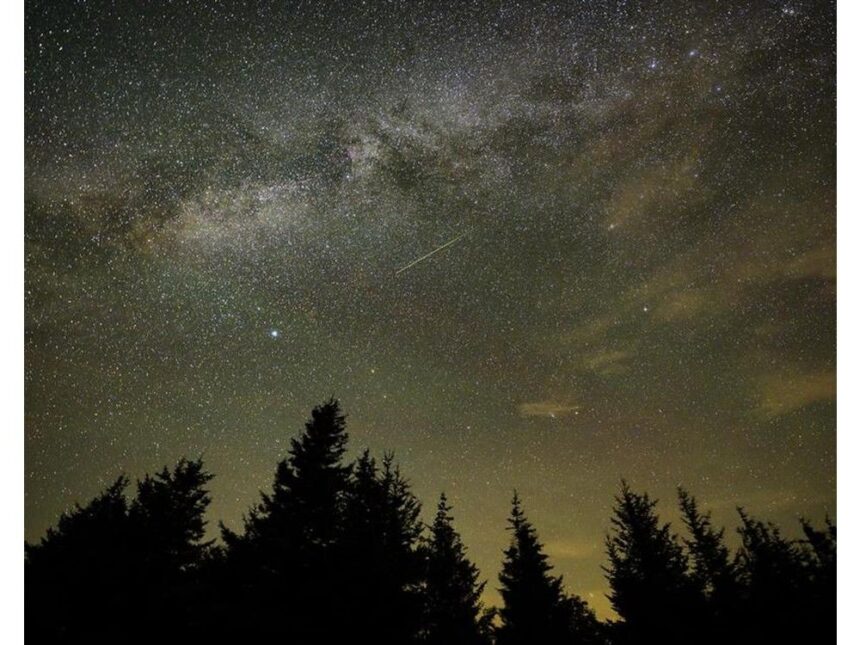The Orionid meteor shower and two comets that appear green will be visible in Atlantic Canada Oct. 20-21Published Oct 16, 2025Last updated 1 hour ago7 minute readIn this 30 second exposure, a meteor streaks across the sky during the annual Perseid meteor shower, Wednesday, Aug. 11, 2021, in Spruce Knob, West Virginia. Photo by NASA/Bill Ingalls /NASA/Bill IngallsArticle contentIf the weather cooperates this coming week, it will be a splendid time to see not only one of the better meteor showers of the year, but also two new comets, which just happen to be green in colour.THIS CONTENT IS RESERVED FOR SUBSCRIBERS ONLY.Subscribe now to access this story and more:Unlimited access to the website and appExclusive access to premium content, newsletters and podcastsFull access to the e-Edition app, an electronic replica of the print edition that you can share, download and comment onEnjoy insights and behind-the-scenes analysis from our award-winning journalistsSupport local journalists and the next generation of journalistsSUBSCRIBE TO UNLOCK MORE ARTICLES.Subscribe or sign in to your account to continue your reading experience.Unlimited access to the website and appExclusive access to premium content, newsletters and podcastsFull access to the e-Edition app, an electronic replica of the print edition that you can share, download and comment onEnjoy insights and behind-the-scenes analysis from our award-winning journalistsSupport local journalists and the next generation of journalistsRegister to unlock more articles.Create an account or sign in to continue your reading experience.Access additional stories every monthShare your thoughts and join the conversation in our commenting communityGet email updates from your favourite authorsSign In or Create an AccountorArticle contentThe Orionids meteor shower is due to peak during the overnight period of Oct. 20-21. As its name implies, the shower’s radiant, or the apparent point of origin of the meteors in the sky, lies in the famous and easily-recognized constellation of Orion – the Hunter, prominent in the autumn/winter eastern night sky.Article contentArticle contentArticle contentThe shower’s apparent point of origin is in the area of Orion’s club, which he holds over his head, just above the bright star Betelgeuse, the giant red star indicating the hunter’s right shoulder (left shoulder as viewed from Earth).Article contentWhere do the Orionids come from?Article contentThe Orionids are debris from the famous Comet Halley, which was named for the English astronomer, mathematician, and physicist Edmond Halley (1656-1742), who predicted its return in 1758, although, unfortunately, he died before its return.Article contentWith a fairly reliable orbital period of about 75-77 years, Comet Halley is the only known short-period (orbital period of less than 200 years) consistently visible to the naked eye; it last visited the inner solar system and swept around the sun in 1986.Article contentThe Orionids are known for their fast (about 238,000 km/hr), brilliant meteors that leave long-lasting trails (“trains”) across the night sky that last for several seconds; the really bright ones are referred to as ‘fireballs’, meteors so bright that they rival the brightness of planets.Article contentArticle content A bright Orionid is captured on the peak night of the shower by a NASA all sky meteor camera in western North Carolina. NASAArticle contentArticle contentHow to see the OrionidsArticle contentThis year’s shower should, weather permitting, be excellent, as the moon will be approaching its ‘new’ phase (9:26 a.m. ADT, Oct. 21), leaving the night sky dark and free of interfering moonlight.Article contentUnder a clear sky from a dark site away from city lights, expect to see approximately 20-30 meteors per hour at the shower’s peak.Article contentAs with all meteor showers, the most meteors observed are when the radiant is at its highest point in the night sky, which, in the case of the Orionids, will be about 4 a.m. ADT.Article contentHowever, don’t think you have to stay up all night into the pre-dawn hours (although this is usually the best meteor-observing period); begin watching for bright Orionids once Orion clears the eastern horizon (or even slightly before) 11 p.m.Article contentDon’t worry if you miss the actual shower peak; the Orionids, a historically reliable meteor shower, are visible, although at a reduced volume, until about Nov. 12.Article contentIf you are planning on observing the Orionids, especially from midnight to dawn, remember to dress for the weather; it is definitely chilly during the overnight period at this time of the year.Article contentNo binoculars or telescopes are necessary to view the Orionids. Get as far away from city lights as possible, give your eyes about 10-20 minutes to dark adapt, and position yourself with your back towards the constellation of Orion.Article contentIf you think you might like to try and capture some pictures of the Orionids as they streak across the sky, you’ll have better success if you use a wide-angle lens, use a high ISO, take long-exposures of 10-30 seconds or more, use a tripod, and preferably use a remote or interval shutter trigger; point your camera at the area just off the shower radiant.Article contentWhat are the new comets?Article contentThe first of the two new comets — Comet Lemmon (C/2025 A6) — was discovered on Jan. 3, 2025, by the Mount Lemmon Survey, which tracks near-earth objects, using telescopes in the Santa Catalina mountains in Arizona, USA.Article contentArticle contentIt is expected to be at its brightest (around mag. +4.0) on Oct. 21, when it makes its closest passage of our planet at approximately 90 million km.Article contentComet Lemmon has an orbital period estimated to be approximately 1,350 years. However, once it makes its closest approach to the sun (perihelion) on Nov. 8, the orbital period is expected to drop closer to 1,150 years, making its next predicted visit to our solar system sometime in the year 3175.Article contentThe second comet — Comet SWAN (C/2025 R2) — was discovered by Ukrainian amateur astronomer Vladimir Bezugly on Sept. 11 of this year while he was reviewing images from the SWAN (Solar Wind ANisotropes) instrument aboard NASA’s Solar and Heliospheric Observatory (SOHO), launched in 1995 to study variations in the sun’s solar wind.Article contentComet SWAN has an estimated orbital period of approximately 22,554 years. Like Comet Lemmon, Comet SWAN is a visitor from the Oort Cloud, the vast region of millions, if not trillions, of primordial icy bodies that forms a huge sphere around the outer edge of our solar system.Article contentArticle content Ahead of Comet Leonard’s close pass of the sun on Jan. 3, 2022, two sun-observing spacecraft captured these views of the comet. NASAArticle contentWhy are they green?Article contentBoth comets display long tails and appear greenish in colour due to the presence of diatomic carbon (two carbon atoms stuck together) in their comas — the cloud of gas, ice and dust that surrounds the comet’s nucleus.Article contentWhen sunlight strikes the molecules of diatomic carbon in the cloud around the coma, they glow with a bright, green light, lending the comets their distinctive greenish hue.Article contentThe brightness of comets is notoriously unpredictable, as a comet may fade or unexpectedly brighten beyond prediction, provided, of course, that they survive their close passage around the sun.Article contentComet Lemmon is currently at about mag. +6.4, but is predicted to brighten to between +4.0 to +2.5 by the time it makes its closest passage of Earth on Oct. 21 at a distance of approximately 90 million kms.Article contentComet SWAN reached perihelion on Sept. 12, one day after its discovery, and is already heading back out into deep space. It currently sits at about magnitude 5.9, but is predicted to possibly brighten to around mag. +4.0 when it makes its closest approach to Earth on Oct. 20 at a distance of approximately 39 million km.Article contentHow can you see the comets?Article contentAlthough it is still unclear at this point whether one or both comets may become visible to the naked eye, both comets should be readily visible in binoculars and small telescopes until the end of the month and possibly into early November.Article contentGiven the exceedingly long orbital periods of both Comet Lemmon and Comet SWAN, make an effort, if you can, to see both these comets — possibly both on the same night — by the end of the month, before they both disappear back into the depths of space.Article contentTo follow the paths of both Comet Lemmon and Comet SWAN across the night sky, go to timeanddate.com/astronomy/night/. Type in your particular location in the upper right-hand corner. When the appropriate page appears, click on the particular comet you wish to find (e.g., Comet C/2025 A6 (Lemmon)) on the left side of the page. Select the date you wish to observe on (click on the small calendar icon next to the date indicator located to the right of center at the bottom of the view screen), and then move the blue circle toggle button at the bottom of the view screen to the left or right to find the best time to view the comet.Article contentArticle contentThis week’s skyArticle contentMercury (mag. -0.2, in Libra – the Scales) is not observable this coming week, as it sits right on the western horizon at dusk.Article contentVenus (mag. -3.9, in Virgo – the Maiden), still shining as our “morning star”, rises around 5:50 a.m. ADT, reaching 14 degrees above the eastern horizon before fading from view into the breaking dawn around 7:15 a.m. ADT.Article contentMars (mag. +1.5, in Libra), soon to pass behind the sun in superior conjunction, is not observable this coming week, as it, like Mercury, sits right on the western horizon at dusk.Article contentJupiter (mag. -2.2, in Gemini – the Twins) becomes accessible around 12:15 a.m. ADT when it reaches seven degrees above the northeast horizon, reaching 65 degrees above the southern horizon by about 7 a.m. ADT, before getting lost in the dawn twilight around 7:15 a.m. ADT, 64 degrees above the southern horizon.Article contentArticle contentSaturn (mag. +0.8, in Aquarius – the Water-bearer), now past opposition, becomes accessible 15 degrees above the southeast horizon by about 6:55 p.m. ADT, reaching its highest point in the sky 39 degrees above the southern horizon shortly after 11 p.m. ADT, and remaining observable until around 3:40 a.m. ADT when it sinks below 11 degrees above the western horizon.Article contentUranus (mag. +5.6, in Taurus – the Bull) becomes accessible 21 degrees above the eastern horizon around 9:50 p.m. ADT, reaching its highest point in the sky 63 degrees above the southern horizon around 3:10 a.m. ADT, and then becoming lost in the dawn twilight 42 degrees above the western horizon by about 6:25 a.m. ADT.Article contentNeptune (mag. +7.8, in Pisces) becomes accessible when it reaches 21 degrees above the southeast horizon around 7:35 p.m. ADT, reaching its highest point in the sky 42 degrees above the southern horizon by about 11:15 p.m., and then becoming inaccessible when it sinks below 21 degrees above the southwest horizon shortly before 3 a.m. ADT.Article contentUntil next week, clear skies.Article contentEvents: Oct. 20 – Comet SWAN’s closest passage of Earth; 39 million km Oct. 20-21 – Orionids meteor shower peak; 10 p.m. to dawn Oct. 21 – Comet Lemmon’s closest passage of Earth (90 million kms); new moon at 9:26 a.m. ADT (9:56 a.m. NDT) Oct. 23 – Moon at apogee; farthest from Earth; approx. 406,700 km; 8:30 p.m. ADT (9:00 p.m. NDT) Oct. 24 – Moon at perihelion; closest point to sunArticle content
ATLANTIC SKIES: How to see bright meteors and two green comets on the same night












